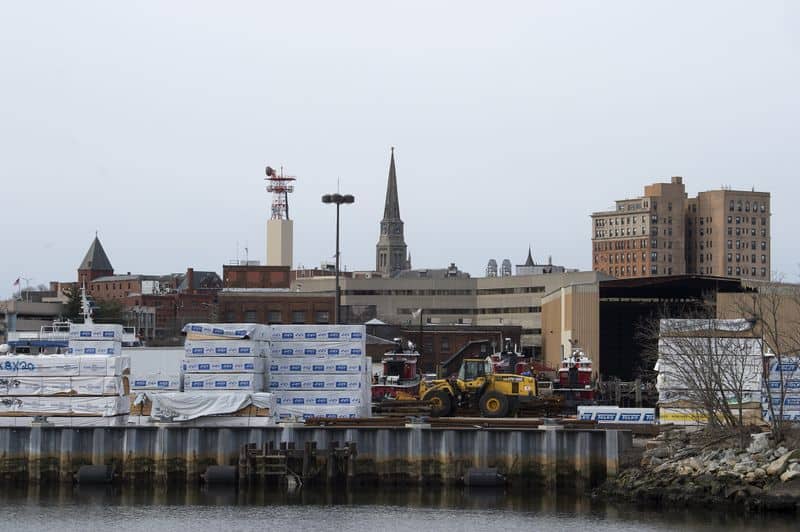
With the Atlantic Ocean at Connecticut’s doorstep, the state is looking for new opportunities to make money from wind turbines rising beyond New London.
The Connecticut Port Authority is looking to raise and spend tens of millions of dollars for “transformational upgrades” at its biggest asset, the State Pier in New London, said Scott Bates, chairman of the board of the Port Authority.
A squat, nondescript administration building dating to the 1960s is set to be replaced, a hill would be leveled to create more usable space and, most importantly, 7 acres between two piers would be filled in to accommodate a heavy lift platform for assembling equipment used for wind turbines that are set down in the ocean off Massachusetts.
State, New London create partnership to boost State Pier and southeast Connecticut’s maritime economy »
The State Pier, built in 1914, functions as a transit point for steel, lumber and other products. On a recent, bitterly cold morning, a ship from Egypt was disgorging salt to waiting trucks.
State economic development officials see greater potential at the State Pier, which was last upgraded in the 1990s. It’s the Port Authority’s largest asset and is “instrumental to its long-term future,” according to the Connecticut Maritime Strategy.
“That ocean out there, that connects us to the world,” Bates said recently at the State Pier’s administration building, waving to the vast area beyond the Thames River. “It’s a blessing of geography and timing. New London is perfectly positioned to be the wind power hub in Connecticut.”
Last June, then-Gov. Dannel P. Malloy announced Connecticut was participating with Massachusetts and Rhode Island to commit to purchasing 1,400 megawatts of offshore wind energy, with 200 megawatts committed by Connecticut.
Deepwater Wind, a wind energy company that has since been purchased by Ørsted, a Danish power company, committed $22.5 million toward upgrades at the State Pier to deploy wind power equipment. In addition, the Port Authority requested money from the State Bond Commission over the past 18 months for upgrades. The Bond Commission has approved the funding, $25 million, which is in reserve to be used with private investment.
As much as $100 million would be needed to revamp the State Pier, including leveling the property, replacing the administration building and creating an area between the piers to accommodate a heavy lift platform for assembling wind turbines, Bates said. Coming up with an additional $52 million in public and private investments to get to the $100 million is “very doable,” Bates said.
Gateway New London LLC, which begins operating the State Pier this year in an agreement calling for a $500,000 annual fee to the Port Authority, also is looking to bring new business, he said. Gateway is committing a minimum of $30 million in capital improvements, infrastructure and equipment at the State Pier over 20 years.
If the State Pier wins a wind power deal, it could help the Port Authority end its state support that now amounts to $400,000 a year to run its operations, Bates said.
“Part of our plan to end it in five years. I’d like to end it earlier,” he said.
Matt Morrissey, head of New England Markets for Ørsted U.S. Offshore Wind, said several ports will be required to deploy wind turbine equipment. Major components are manufactured overseas and shipped to the U.S., requiring a substantial amount of work at domestic sites, he said.
“The State Pier in New London figures very well in the larger story of offshore wind’s advance in the Northeast,” he said.
As much as 19,000 megawatts of offshore wind energy have been committed from Northeast states such as Connecticut, Massachusetts, New Jersey, New York and Rhode Island, Morrissey said.
Ørsted’s project, Revolution Wind, is expected to be under construction from 2022 to 2023 and establish more than 300 local development and construction jobs. It will be about 40 miles from Connecticut and 15 miles south of Martha’s Vineyard.
New London Mayor Michael Passero said the selection of the State Pier for assembling wind turbines could boost southeast Connecticut’s manufacturing supply chain, fabricating and welding businesses and construction industry.
“All these manufacturing facilities can be repurposed,” he said. “There are all sorts of possibilities.”
The wind power industry is growing rapidly. It’s attracting private investment — Eversource announced last month it’s spending $225 million for a 50 percent stake in Ørsted projects in the Atlantic Ocean and a tract off Massachusetts and Rhode Island — and interest from states looking to include more zero-carbon sources of power in their energy portfolios.
At the State Pier, other advantages include an absence of overhead barriers, such as bridges, and no channel restrictions, said Evan Matthews, executive director of the Connecticut Port Authority.
Bates, a football fan, sees an analogy between the early stages of developing the State Pier’s potential and the gridiron.
“We’re at the 2-yard line,” he said. “We have to put our head down and smash against the line and get it done.”
